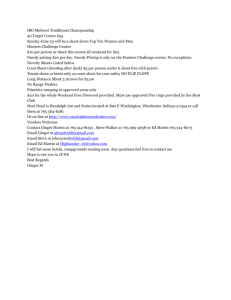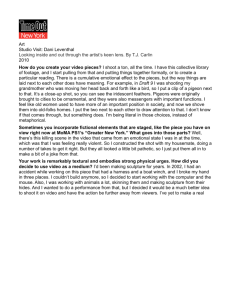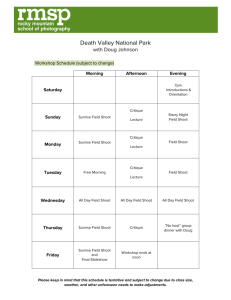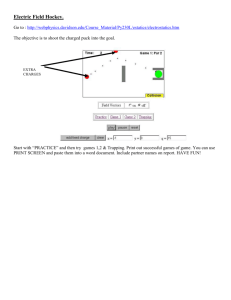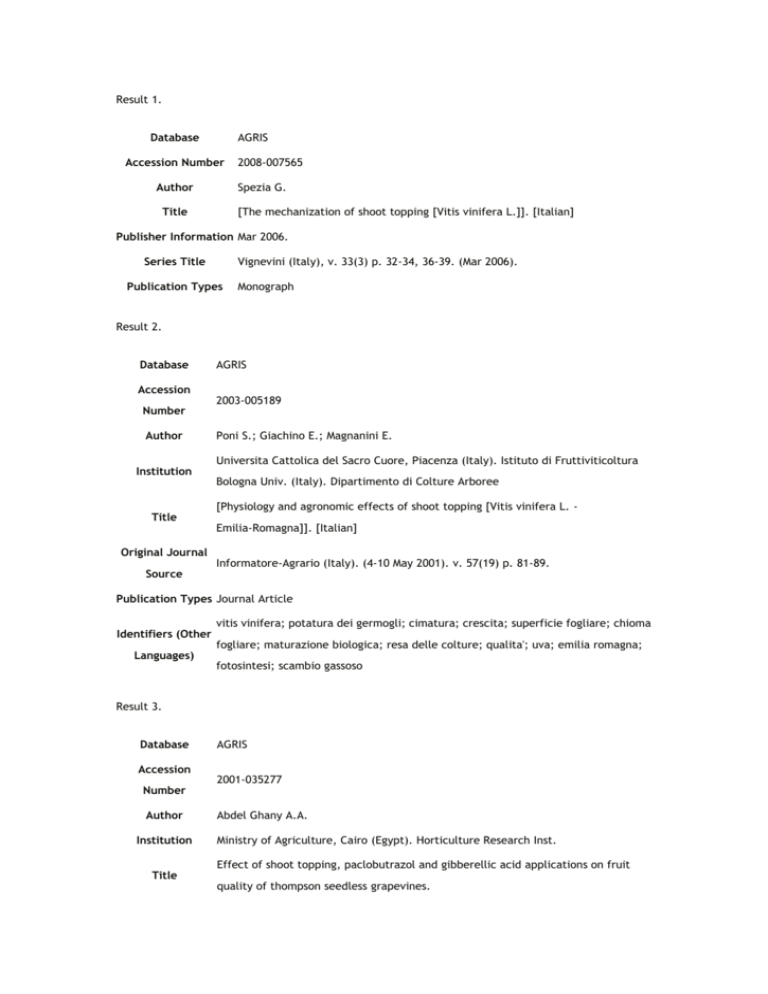
Result 1.
Database
AGRIS
Accession Number
Author
2008-007565
Spezia G.
Title
[The mechanization of shoot topping [Vitis vinifera L.]]. [Italian]
Publisher Information Mar 2006.
Series Title
Vignevini (Italy), v. 33(3) p. 32-34, 36-39. (Mar 2006).
Publication Types
Monograph
Result 2.
Database
Accession
Number
Author
Institution
Title
Original Journal
Source
AGRIS
2003-005189
Poni S.; Giachino E.; Magnanini E.
Universita Cattolica del Sacro Cuore, Piacenza (Italy). Istituto di Fruttiviticoltura
Bologna Univ. (Italy). Dipartimento di Colture Arboree
[Physiology and agronomic effects of shoot topping [Vitis vinifera L. Emilia-Romagna]]. [Italian]
Informatore-Agrario (Italy). (4-10 May 2001). v. 57(19) p. 81-89.
Publication Types Journal Article
Identifiers (Other
Languages)
vitis vinifera; potatura dei germogli; cimatura; crescita; superficie fogliare; chioma
fogliare; maturazione biologica; resa delle colture; qualita'; uva; emilia romagna;
fotosintesi; scambio gassoso
Result 3.
Database
Accession
Number
Author
Institution
Title
AGRIS
2001-035277
Abdel Ghany A.A.
Ministry of Agriculture, Cairo (Egypt). Horticulture Research Inst.
Effect of shoot topping, paclobutrazol and gibberellic acid applications on fruit
quality of thompson seedless grapevines.
Original Journal
Source
Assiut-Journal-of-Agricultural-Sciences (Egypt). (2000). v. 31(2) p. 49-58.
Publication Types Journal Article; Summary
Result 4.
Database
AGRIS
Accession Number
Author
1994-074413
Isara Sooksathan
Corporate/Conference
Author
Institution
8. Thailand National Groundnut Meeting. Roi-Et (Thailand). 3-5 May 1989.
Kasetsart Univ., Bangkok (Thailand). Faculty of Agriculture
Title
Effects of shoot topping on yield of two groundnut cultivars.
Khon Kaen Univ., Khon Kaen (Thailand). Faculty of Agriculture. Proceedings
Publisher Information
of the eight Thailand National Groundnut Meeting. Raingan kan sammana
thualisong haeng chat khrang thi 8. Khon Kaen (Thailand). 1989. p. 257-261.
Received 1992.
Publication Types
Monograph; Conference; Numerical Data; Summary; Non Conventional
Two experiments were conducted at the National Corn and Sorghum Research
Center at Nakhon Ratchasima province during March to July 1988 examining
the effect of shoot topping on yield of groundnut cultivars SK.38 and Tainan 9.
Shoot toppings were done at 60, 70, 80 and 90 days after emergence by three
methods. The methods of cutting were cutting main stem only, cutting all
shoots combined together, and cutting each shoot separately. Heights of
Abstract (English)
cutting were 30 and 40 cm. from stem base. The topping treatments were
compared with a control and a SADH sprayed at 1.2 kg a.i/ha at 50 DAE. For
SK.38, shoot topping at 80 DAE by cutting all shoot combined together at 40
cm. produced highest pod yield, while cutting main stem at the same age at
30 cm. gave highest pod yield in the cultivar Tainan 9. These two treatments
gave fresh weight of the removed plant parts of 5,333 and 400 kg/ha,
respectively.
Result 5.
Database
AGRIS
Accession Number 1994-095303
Author
Hassan A.H.; Abd El Kawi A.A.
Institution
Title
Mansoura Univ. (Egypt). Faculty of Agriculture
Leaf removal and shoot topping as effective methods for improving grape quality.
Original Journal Journal-of-Agricultural-Sciences,-Mansoura-Univ. (Egypt). (Jul 1992). v. 17(7) p.
Source
2428-2433. Issued 1994.
Publication Types Journal Article; Numerical Data; Summary
Result 6.
Database
Accession Number
Author
AGRIS
1986-023777
Suphattra Supphamethi
Corporate/Conference Kasetsart Univ., Bangkok (Thailand). Faculty of Agriculture. Dept. of
Author
Horticulture.
Publisher Information Bangkok (Thailand). 1984. 12 leaves.
Publication Types
Monograph; Summary; Non Conventional
Three level of ethephon 1000, 1500 and 2000 ppm. were used. The solution
were sprayed on the multiflora rose rootstock budded with Christian Dior
variety to stunt the top growth of root. The result showed that every level of
ethephon treatments gave the less percentage of grafted bud break. The
Abstract (English)
topping and non-topping treatments gave 83.3 and 58.3 percent while the
ethephon treatment of 1000, 1500 and 2000 ppm. gave 45.8, 16.7 and 25
percent respectively. The average lengths of the grafted shoot of topping and
non-topping are 11.25 cm. and 10.52 cm. The ethephon treatment of 1000,
1500 and 2000 ppm. are 5.275, 4.875 and 2.05 cm. respectively.
Result 7.
Database
Accession Number
Author
Corporate/Conference
Author
Institution
Title
AGRIS
1988-001478
Koblet W.
22. International Horticultural Congress. Davis, CA (USA). 11-20 Aug 1986.
Swiss Federal Research Station, Waedenswil (Switzerland)
Effectiveness of shoot topping and leaf removal as a means of improving
quality.
Publisher Information Kliewer,-W.M. (California Univ., Davis, CA (USA). Dept. of Viticulture and
Enology). International Society for Horticultural Science (ISHS). Symposium
on grapevine canopy and vigor management. Wageningen (Netherlands).
ISHS. 1987. p. 141-156.
Series Title
Publication Types
Acta Horticulturae (Netherlands). no. 206.
Monograph; Conference; Summary
Result 8.
Database
Accession Number
Author
AGRIS
1984-012146
Intrieri C.; Maganini E.; Silvestroni O.
Corporate/Conference Giornata di studio sul miglioramento delle produzioni vitivinicole. Faenza
Author
Institution
Title
(Italy). 17 Apr 1982.
Bologna Univ. (Italy). Istituto di Coltivazioni Arboree
[Effects of summer pruning on the vegetative and productive behaviour of
vinegrape (Vitis vinifera L.)]. [Conference paper]. [Italian]
Original Journal Source Vignevini (Italy). (May 1983). v. 10(5) p. 57-62.
Publication Types
Journal Article; Conference; Numerical Data; Summary
The effects of summer pruning applied about 1, 7 or 11 weeks after anthesis,
were studied on "Albana" and on "Sangiovese" grape cvs., respectively
"Duplex" and "G.D.C." trained. During two years, pruning was performed,
topping the hanging shoots and measuring the leaf area retained and
removed. After pruning the berry growth and the ripening were followed; at
harvest the leaf area replacement was recorded. As compared to the
unpruned vines, the shoot topping shortly after anthesis increased berry
growth and acidity accumulation during the period I (cell division); during
Abstract (English)
period III (cell enlargment), the berry growth was also greater, the soluble
solids accumulation was enhanced and the total acidity decreased more
rapidly. In contrast the shoot topping 7 weeks after anthesis (end of period II)
decreased berry growth, soluble solids accumulation and acidity degradation.
Similar, but lesser, effects were recorded in vines pruned II weeks after
anthesis (middle of period III). In conclusion, topping on period I enhanced
ripening because the early growth of laterals replaced the mature leaf area in
the period III. On the contrary, topping on period II or on period III delayed
ripening for the removal of mature leaves and for the competitive effects of
young laterals on clusters.
Abstract (Other
ITALIANO: Sono stati studiati gli effetti della potatura verde attuata 1, 7 o 11
Languages)
settimane dopo la piena fioritura sulle cultivar "Albana" e "Sangiovese"
rispettivamente allevate a "Duplex" e a "G.D.C.". Per due anni la potatura
venne effettuata cimando i germogli e misurando l'area fogliare rimasta e
quella asportata. Dopo la potatura venne seguita la crescita e la maturazione
degli acini. Alla vendemmia venne nuovamente misurata l'area fogliare.
Rispetto alle viti non cimate, la cimatura effettuata subito dopo la piena
fioritura aumento la crescita degli acini e l'accumulo dell'acidita durante il I
periodo (moltiplicazione cellulare); per tutto il III periodo (distensione
cellulare) la crescita degli acini si mantenne piu veloce, l'accumulo degli
zuccheri venne accelerato e l'acidita diminui piu rapidamente. Al contrario, la
cimatura a 7 settimane dopo la piena fioritura (fine del II periodo) diminui la
crescita degli acini, l'accumulo degli zuccheri e la degradazione dell'acidita.
Effetti simili, ma meno marcati furono ottenuti nelle viti cimate II settimane
dopo la fioritura (circa a metta del III periodo).
Result 9.
Database
AGRIS
Accession Number 1976-093730
Author
Satoh M.
Institution
The effect of shoot topping on growth and photosynthetic activity of remained
Title
leaves in young mulberry plants.
Original Journal
Source
Sericultural Experiment Station, Tokyo (Japan)
Acta-Sericologica (Japan). (Nov 1975). (no.96) p. 6-13.
Publication Types Journal Article; Summary
Result 10.
Database
Accession
Number
Author
Food Science and Technology Abstracts
1999-11-Hj2198
Keller, M., Pool, R. M., Henick-Kling, T.
Author's
Sch. of Wine & Food Sci., Charles Sturt Univ., Wagga Wagga, NSW 2678, Australia. Fax 61
Address
2 6933 2107. E-mail mkeller@csu.edu.au
Title
Excessive nitrogen supply and shoot trimming can impair colour development in Pinot
Noir grapes and wine.
Source
Publication
Type
Australian Journal of Grape & Wine Research. 5, (2): 45-55, 1999.
Journal Article
ANTHOCYANINS
COLOUR
Subject
CULTIVATION
Headings
FERTILIZERS
WINEMAKING GRAPES
WINES
Effects of N supply and shoot trimming on mature, field grown Pinot Noir (Vitis vinifera
L.) vines were investigated. Ammonium nitrate (0, 30, 60 or 90 kg/ha) was applied at the
beginning of flowering. Shoots were topped either once (at fruit set) or twice (at fruit set
or during the lag phase of berry growth). Neither treatment affected grape berry and skin
wt., yield or grape sugar, but high rates of N increased malic acid and reduced skin
phenols, flavonols and anthocyanins. Malvidin-3-glucoside was the most abundant
anthocyanin in skins and wine: it accounted for 75% of total anthocyanins at the beginning
of fermentation and its relative proportion increased to 95% in finished wine. Increases in
Abstract
anthocyanin concn. at the beginning of fermentation and before malolactic fermentation
were followed by declines during the later stages of alcoholic and malolactic
fermentation. High N supply decreased anthocyanins in the juice and wine, increased pH
and increased percentage of malvidin-3-glucoside. Repeated shoot topping gave lower
wine total phenols and anthocyanins and thus enhanced the nitrogen effect. Wine
susceptibility to oxidation increased with higher pH and lower anthocyanin contents. The
best treatment combination for fruit and wine quality, in terms of colour and oxidative
stability, was low N/single topping, and the worst combination was high N/repeated
topping. These results suggest that a combination of high rates of N fertilizer and
repeated shoot trimming can decrease potential fruit and wine quality.
* Copyright 1999 International Food Information Service (IFIS Publishing). All Rights
Reserved. *
Result 11.
Database
Accession
Number
Author
Author's
Food Science and Technology Abstracts
1991-05-Hz0051
Wolf, T. K., Zoecklein, B. W., Cook, M. K., Cottingham, C. K.
Virginia Agric. Exp. Sta. Winchester, 2500 Valley Ave., Winchester, VA 22601, USA
Address
Title
Source
Publication
Type
Shoot topping and ethephon effects on white Riesling grapes and grapevines.
American Journal of Enology & Viticulture. 41, (4): 330-341, 1990.
Journal Article
ETHREL
VINES
CULTIVATION
Subject
Headings
ETHEPHON
FRUITS
GRAPES
PLANT GROWTH REGULATORS
WINEMAKING
WINEMAKING GRAPES
Canopy modification by shoot topping or ethephon application was examined with
pendelbogen-trained White Riesling grapevines in the hot, humid Piedmont region of
Virginia. Treatments were: control, 2 levels of shoot topping (10 vs. 20 leaves/shoot
retained) or ethephon application to shoot tips (600 mg/l). Topping shoots to maintain 10
or 20 leaves/shoot reduced annual cane pruning wt. by an average of 61 or 24%, resp.,
compared with non-topped vines. Application of ethephon produced a vine size
comparable to that of vines hedged to 20 leaves/shoot. Canopy insolation was least with
Abstract
control vines (due to shoot tops shading original canopy) and similar among other
treatments. Vines topped to 20 leaves/shoot produced more fruit than vines topped to 10
leaves/shoot. More fruit was harvested from shoot-topped vines than from control vines
in 2 of 3 yr. Greatest fruit soluble solids at harvest were generally observed with vines
topped to 20 leaves/shoot. Shoot topping resulted in fruit with lower titratable acidity at
harvest than with control vines, but fruit pH was not appreciably affected by any
treatment. Shoot topping to 15-20 leaves/shoot appears appropriate with vigorous,
low-trained White Riesling to maximize benefits of this remedial canopy management
practice in the humid mid-Atlantic United States.
* Copyright 1990 International Food Information Service (IFIS Publishing). All Rights
Reserved. *
Result 12.
Database
CAB Abstracts
Accession
20093156829
Number
Lorenzo, R. di; Scafidi, P.; Pisciotta, A.; Santangelo, T.; Asmundo, C. N.; Barbagallo, M.
Author
G.
Dipartimento di Colture Arboree, Universita degli Studi di Palermo, 90100 Palermo,
Institution
Italy.
Effect of canopy management practices on vegeto - reproductive behaviour of cv.
Title
Malvasia delle Lipari.
Source
Rivista di Viticoltura e di Enologia. 2008/2009. 61/62: 2-4/1, 361-367. 22 ref.
Publisher
Unione ex Allievi della Scuola di Viticoltura e di Enologia di Conegliano
Location of
Publisher
Country of
Publication
Conegliano
Italy
Influence of shoot topping and bunch zone leaf removal were investigated on cv.
Malvasia delle Lipari Vitis vinifera L. vertically trained and cane pruned. Typical of
Malvasia delle Lipari is high shoot vigor, downward orientated shoot, instability of
Abstract
production, determined by less bunch compactness, and finally less bud fertility. Canopy
management practices affected berry weight, technological ripening parameters, and
berry colorimetric characteristics, especially for the shade while the reduction of source
didn't affect brightness, quaver and aromatic compounds.
aromatic compounds
chemical composition
crop quality
fruits
Subject
grapes
Headings
plant composition
ripening
shoot pruning
topping
Publication
Type
Journal article.
Result 13.
Database CAB Abstracts
Accession
Number
20083314614
Author
Institution
Dardeniz, A.; Yldrm, I.; Gokbayrak, Z.; Akcal, A.
Hoticulture Department, Agriculture Faculty, Canakkale Onsekizmart University, 17020,
Canakkale, Turkey.
Title
Influence of shoot topping on yield and quality of Vitis vinifera L.
Source
African Journal of Biotechnology. 2008. 7: 20, 3628-3631. 20 ref.
Publisher Academic Journals
Location of
Publisher
Country of
Publication
Nairobi
Kenya
This study was carried out in a 20 year old spur pruned Karasakz (Kuntra) vineyard during
the 2003 and 2004 growth season. Vines were topped at 1, 3 and 5 nodes beyond the last
Abstract
cluster on the main shoot. Yield and quality parameters were analyzed to determine the
effects of shoot topping. The results showed that weather conditions had more statistically
important effects compared to the topping level. One (1) node topping resulted in more
loss of yield due to increased vegetative growth.
crop quality
Subject
Headings
crop yield
grapes
shoots
topping
Publication
Type
URL
Journal article.
http://www.academicjournals.org/AJB/PDF/pdf2008/20Oct/Dardeniz%20et%20al.pdf
Result 14.
Database
Accession
Number
Author
Institution
Title
Source
CAB Abstracts
20083055077
Benismail, M. C.; Bennaouar, M.; Elmribti, A.
Department of Horticulture, Institut Agronomique et Veterinaire Hassan II, BP: 18S,
80000 Agadir, Morocco.
Effect of bud load and canopy management on growth and yield components of grape cv.
'Cardinal' under mild climatic conditions of Agadir area of Morocco.
Acta Horticulturae. 2007. 754, 197-203. 11 ref.
Publisher
Location of
Publisher
Country of
Publication
Price
International Society for Horticultural Science (ISHS)
Leuven
Belgium
119 EURO
The effect on growth and development of different bud loads (14, 20, 30 and 40 latent
buds per vine) combined with shoot topping at the beginning or at the end of flowering
was studied on 6 years old 'Cardinal' grapevine. Topping treatments were done at the
level of the 10th leaf. The vines were growing under winter mild climatic conditions of
Agadir area (Morocco). The experiment showed that bud fertility and vegetative growth
(bud burst and secondary shoot development) were reduced with the increase of bud
number per plant. Sprouting capacity is reduced by 76.7 to 53.7% when bud load
Abstract
increases from 14 to 40 buds; whilst there is a 63.8% increase in yield, due to the number
of bunches per vine. Shoot topping enhances canopy development through stimulation of
lateral bud growth. This enhancement is higher when bud load was low and topping
occurs at the early stage. In vines with a load of 20 buds, topped at the end of flowering,
grape production was improved by 31.3% with a 6.6% reduction in soluble sugar content.
These results show that the production of vine grown under conditions with lack of
chilling may be improved by the adoption of an appropriated plant management with the
aim of establishing a balance between vegetative growth and fruit development.
buds
canopy
crop yield
fertility
Subject
Headings
grapes
growth
plant development
shoots
sprouting
sugar content
topping
Publication Journal article
Type
Conference paper.
URL
http://www.actahort.org
Result 15.
Database
Accession
Number
Author
Institution
Title
Source
Publisher
Location of
Publisher
Country of
Publication
CAB Abstracts
20073276273
Belvini, P.; Costa, L. dalla; Bei, R. de; Genovese, D.; Ponchia, G.
C.E.C.A.T. (Centro per l'Educazione la Cooperazione e l'Assistenza Tecnica), Universita
di Padova, Padova, Italy.
Management of urine foliage: effect of trimming shoots on vegeto-productive
parameters.
Vignevini. 2007. 34: 11, 155-160.
Il Sole 24 Ore Edagricole Srl
Bologna
Italy
A study was conducted in a 6-year-old vineyard in Italy during 2003-05 to evaluate the
effect of shoot trimming severity on the vegetative growth and yield of free
cordon-trained grape cultivars Pinot grigio and Chardonnay. Seven trimming treatments
were applied concerning time of execution (after and before flowering) and severity of
shoot trimming (35 and 50 cm of shoot length). During the growing seasons, the
Abstract
vegetative parameters, berry development, sugar content and titratable acidity
evolution were monitored. At harvest, the quantity and quality of grapes were assessed.
Short trimming led to canopies with upward shoots. Shoot topping led to a greater
cluster weight than that observed in the control but there were no overall effects on
yield and sugar content of the berries. Trimming influenced dry matter partitioning,
causing a strong reduction in leaf area. A positive, parabolic type, correlation was found
between sugar content and leaf area/yield ratio.
correlation analysis
crop yield
cultivars
dry matter distribution
Subject
fruits
Headings
grapes
growth
leaf area
pruning
shoots
sugar content
titratable acidity
Publication
Type
Journal Article.
Result 16.
Database
Accession
Number
Author
Institution
Title
Source
Publisher
Location of
Publisher
Country of
Publication
CAB Abstracts
20063237544
El-Sharkawy, S. M. M.
Horticulture Research Institute, Giza, Egypt.
Effect of pruning levels and boron and urea sprays on fruit set, yield and fruit quality of
olive trees.
Annals of Agricultural Science, Moshtohor. 2003. 41: 3, 1307-1322. 32 ref.
Faculty of Agriculture, Zagazig University
Moshtohor
Egypt
The response of Aggizi shami olives to pruning levels (shoot tipping or removal of the
apical 1/4 of the shoot during first inflorescence emergence in March) and spraying with
B at 300 and 600 ppm, associated with 5% urea, at full bloom was evaluated during 2002
and 2003 in Egypt. B at 300 ppm + urea was the most effective treatment in increasing
Abstract
perfect flower number, fruit set and fruit number/tree. The removal of the apical 1/4
part of the shoot, combined with application of B at 300 ppm + urea resulted in the
highest decrease in fruit shedding. Shoot topping combined with B at 300 ppm + urea
produced the highest yield. Pruning, with or without B + urea treatment, resulted in the
highest values of fruit quality and oil content.
boron fertilizers
crop quality
crop yield
Subject
flowering
Headings
fruit set
fruiting
growth
olives
plant development
plant oils
pruning
spraying
urea fertilizers
Publication
Type
Journal article.
Result 17.
Database
Accession
Number
Author
Institution
Title
Source
Publisher
Location of
Publisher
Country of
Publication
CAB Abstracts
20063174868
Melouk, A. M.; Habib, S. S.; El-Khorieby, A. M.; Saif, M. I.
Faculty of Agriculture, Suez Canal University, Ismailia, Egypt.
Effect of summer pruning on bud behaviour, growth and productivity of Thompson
Seedless grapevines.
Annals of Agricultural Science, Moshtohor. 1999. 37: 4, 2633-2650. 30 ref.
Faculty of Agriculture, Zagazig University
Moshtohor
Egypt
Grapes cv. Thompson Seedless were subjected to different types of pruning (lateral
shoot removal; shoot tip removal; shoot topping at the twentieth node; shoot topping at
fifteenth node; and shoot topping at tenth node) after blooming and at veraison in a
field experiment conducted in Egypt during 1995-98. Postbloom pruning reduced bud
burst, fertility, yield, number of clusters, and total soluble solid (TSS) content of the
fruits compared to vines pruned at veraison. Cluster weight and total carbohydrates
Abstract
were not affected by pruning times, whereas the total acidity and TSS:acid ratio of the
fruits fluctuated. A significant reduction in bud burst, fertility, yield, cluster number
and total cane carbohydrate content were observed with increasing pruning severity.
TSS, total acidity and TSS:acid ratio were slightly affected by pruning severity. Bud burst
and fertility on the cane decreased as pruning severity increased, regardless of the crop
growth stage when pruning was carried out. Early or late shoot topping of the tenth node
reduced the yield, cluster dimensions and total cane carbohydrate content, whereas
total acidity was not significantly influenced by this interaction. Summer pruning by
shoot tipping or lateral shoot removal either at postbloom or at veraison is
recommended for cv. Thompson Seedless. This technique resulted in better bud burst,
fertility and yield and improved fruit quality while maintaining vine size. Severe summer
pruning should be used as a corrective method to reduce excess vigour and improve
canopy characteristics.
acidity
buds
carbohydrates
chemical composition
Subject
Headings
crop quality
crop yield
fruits
grapes
growth
pruning
Publication
Type
Journal article.
Result 18.
Database
Accession
Number
Author
Title
Source
Publisher
Location of
Publisher
Country of
Publication
CAB Abstracts
20063054342
Spezia, G.
Mechanical topping and defoliation.
Vignevini. 2006. 33: 3, 31-49.
Il Sole 24 Ore Edagricole Srl
Bologna
Italy
In this special section, machines available for canopy management in vines are
presented. The first part addresses mechanising shoot topping. Machines for either
Abstract
straight or rotary cutting are described and lavishly illustrated. They may be carried in
front, to the side of or behind an interrow tractor. Tunnel cutting machines are
included. The second part outlines the evolution of mechanical defoliators. Recent
developments in this type of machine are discussed. It is stressed that machines can
operate only on the outside of the canopy whereas manual defoliation can be effected
within it. Thus vines must be uniform in shape for mechanical operations and it may be
desirable that they should be of the same variety. Machines may be used pre-harvest to
expose the bunches of fruit. Different kinds of machine described include pneumatic,
those using various types of suction, those with flexible rotating drums, thermal and
those with grabs.
canopy
cutters
defoliation
equipment
grapes
Subject
Headings
management
mechanization
pneumatic power
rotary cutting
shoots
topping
tunnels
vineyards
Publication
Type
Journal article.
Result 19.
Database
Accession
Number
Author
Institution
Title
Source
Publisher
Location of
Publisher
Country of
Publication
Abstract
CAB Abstracts
20033072856
Fathi, M. A.; Mokhtar, H.
Hort Res. Institute, Agric. Res. Centre, Giza, Egypt.
Influence of summer pruning on growth, fruit set and fruit quality of Anna apple trees.
Egyptian Journal of Agricultural Research. 1998. 76: 2, 721-732. 20 ref.
Agricultural Research Centre, Ministry of Agriculture and Land Reclamation
Giza
Egypt
The effect of summer pruning and shoot topping in April, May or June on Anna apple
(Malus domestica [M. pumila]) trees/M.M. 106 were studied through 1995/96 seasons to
investigate the response on growth rate, leaf mineral content, productivity, fruit
characters, and fruit mineral content. The growth rate of shoot length, number of
shoots, leaf area, and dry matter increased after summer pruning and shoot topping.
Also, the leaves of pruned trees accumulated much more nutrient elements (N, P, K).
Productivity parameters (percentage of fruit set, number of spurs in one meter of a main
scafold, and spurs' number per pruned tree) apparently increased with pruning
treatments. Pre-harvest fruit abscission significantly decreased, may be as a result of
raising the level of potassium in both leaf and fruit. Although the number of mature
fruits per tree decreased, fruit quality characters (fruit weight, volume, firmness, total
soluble solids (TSS), acidity and TSS/ratio), and fruit nutrient elements content (N, P, K,
Ca) increased. The influence of summer pruning was found to be linearly related to its
severity (the length of removed shoot). However, pruning in May was better than in April
or June.
apples
calcium
chemical composition
fruit set
fruits
growth rate
leaves
Subject
Headings
mineral content
nitrogen
phosphorus
plant composition
potassium
pruning
shoots
summer
topping
yields
Publication
Type
Journal article.
Result 20.
Database
CAB Abstracts
Accession
20033072881
Number
Author
Institution
Title
Source
Publisher
Location of
Publisher
Country of
Publication
Fathi, M. A.; Mokhtar, H.
Hort Res. Institute, Agric. Res. Centre, Giza, Egypt.
Influence of summer pruning on growth, fruit set and fruit quality of Anna apple trees.
Egyptian Journal of Agricultural Research. 1998. 76: 3, 1159-1170. 20 ref.
Agricultural Research Centre, Ministry of Agriculture and Land Reclamation
Giza
Egypt
The effect of summer pruning and shoot topping in April, May or June the growth rate,
leaf mineral content, productivity, fruit characters and fruit mineral content of Anna
apple (Malus domestica [M. pumila]) trees grafted on rootstock M.M. 106 were studied in
1995-96 at El-Kanater Experimental Station, Egypt. The growth rate of shoot length,
number of shoots, leaf area and dry matter increased after summer pruning and shoot
topping. Also, the leaves of pruned trees accumulated much more N, P and K.
Productivity parameters (percentage of fruit set, number of spurs in one metre of a main
Abstract
scafold, and number of spurs per pruned tree) apparently increased with pruning
treatments. Preharvest fruit abscission significantly decreased, maybe as a result of
raising the level of K in both leaf and fruit. Although the number of mature fruits per
tree decreased, fruit quality characters (fruit weight, volume, firmness, total soluble
solids (TSS), acidity and TSS/acid ratio), and fruit nutrient content (N, P, K and Ca)
increased. The influence of summer pruning was found to be linearly related to its
severity (the length of removed shoot). However, pruning in May was better than in April
or June.
acidity
apples
crop quality
crop yield
dry matter accumulation
Subject
firmness
Headings
fruit set
fruits
growth rate
leaf area
leaves
mineral content
nitrogen
nitrogen content
nutrient content
phosphorus
plant nutrition
potassium
pruning
shoots
topping
Publication
Type
Journal article.
Result 21.
Database
Accession
Number
Author
Institution
Title
Source
Publisher
Location of
Publisher
Country of
Publication
CAB Abstracts
20023095762
Poni, S.; Zamboni, M.; Gasparinetti, P.
Istituto di fruttiviticoltura, Universita Cattolica del Sacro Cuore, Piacenza, Italy.
Early shoot topping of open cordon-grown Pinot noir.
Informatore Agrario. 2002. 58: 24, 57-63.
Edizioni l'Informatore Agrario Srl
Verona
Italy
In 10-year-old vines grown in Italy on cordons 1.7 m above the ground, topping left
either 11 (C11) or 7 (C7) leaves on the main shoot. Observation showed that early,
severe topping delayed fruit ripening and reduced soluble solid concentrations.
Abstract
Regrowth after topping is strongly affected by the weather and severe topping may lead
to insufficient regrowth , especially in dry seasons. In general, the less drastic topping
(C11) seems preferable, encouraging erect growth of the shoots. Over the 3 years of the
trial, grape production was not significantly affected by the different topping regimes
but the delayed ripening induced by C7 may benefit winemaking in very hot climates.
Subject
Headings
chemical composition
crop yield
grapes
growth
plant training
pruning
topping
vineyards
winemaking
Publication
Type
Journal article.
Result 22.
Database
Accession
Number
Author
CAB Abstracts
20000316610
El-Ghany, A. A. A.
Institution Hort. Res. Institute, Agric. Res. Center, Cairo, Egypt.
Title
Source
Effect of shoot topping, paclobutrazol and gibberellic acid applications on fruit quality of
Thompson seedless grapevines.
Assiut Journal of Agricultural Sciences. 2000. 31: 2, 49-58. 25 ref.
An experiment carried out during 1996 and 1997 on 8-year-old Thompson seedless
grapevines at a private vineyard located in Kafr Daood, Monofia Governorate, examined
the effects of shoot topping (retaining 20 leaves per shoot) at one week after fruit set,
spraying with paclobutrazol (PB, 500 ppm) at 5 weeks after set and gibberellic acid (GA 3
Abstract
10 ppm) at full bloom and/or (GA3 50 ppm) at one week after fruit set. Application of PB
and/or shoot topping of vines, combined with GA3, increased TSS, total and reducing
sugars compared with GA3 alone. All GA3 applications increased weight and size of
berries. GA3 alone increased acidity, while, GA3 + PB or topping had no effect on acidity.
Application of GA3 at 10 ppm increased shot berries.
foliar application
fruits
gibberellic acid
Subject
Headings
gibberellins
grapes
paclobutrazol
plant growth regulators
quality
reducing sugars
topping
Publication
Type
Journal article.
Result 23.
Database
Accession
Number
Author
Institution
Title
Source
CAB Abstracts
19990310881
Keller, M.; Pool, R. M.; Henick-Kling, T.
School of Wine and Food Sciences, Charles Sturt University, Wagga Wagga, NSW 2678,
Australia.
Excessive nitrogen supply and shoot trimming can impair colour development in Pinot
Noir grapes and wine.
Australian Journal of Grape and Wine Research. 1999. 5: 2, 45-55. 47 ref.
The effects of N supply and shoot trimming on mature, field-grown Pinot Noir (Vitis
vinifera) vines were studied in New York state. Ammonium nitrate (0, 30, 60 or 90 kg
N/ha) was applied at the beginning of flowering. Shoots were topped either once (at fruit
set), or twice (at fruit set and during the lag-phase of berry growth). Neither treatment
affected grape berry and skin weights, yield and grape sugar, but high rates of N
increased malic acid and reduced skin phenols, flavonols and anthocyanins.
Malvidin-3-glucoside was the most abundant anthocyanin in skins and wine. It accounted
for 75% of the total anthocyanins at the beginning of fermentation and its relative
Abstract
proportion increased to 95% in the finished wine. Increases in anthocyanin concentration
at the beginning of fermentation and before malolactic fermentation, were followed by
declines during the later stages of alcoholic and malolactic fermentation. High N supply
decreased anthocyanins in the juice and wine, increased pH and increased the
percentage of malvidin-3-glucoside. Repeated shoot topping gave lower wine total
phenols and anthocyanins and thus enhanced the N effect. Wine susceptibility to
oxidation increased with higher pH and lower anthocyanin content. The best treatment
combination for fruit and wine quality, in terms of colour and oxidative stability, was low
N/single topping and the worst combination was high N/repeated topping.
ammonium nitrate
Subject
Headings
anthocyanins
fermentation
flavonols
flowering
fruit crops
fruit set
fruits
grapes
malic acid
nitrogen fertilizers
oxidation
phenols
temperate fruits
topping
Publication
Type
Journal article.
Result 24.
Database
Accession
Number
Author
Institution
Title
Source
CAB Abstracts
19980300005
Gay, G.; Morando, A.; Bica, D.
Centro di Studio per il Miglioramento Genetico e la Biologia della Vite - CNR, Via P. Giuria
15, 10126 Torino, Italy.
Quality response of six Vitis vinifera cultivars to shoot topping.
Acta Horticulturae. 1997. 427, 161-168. 12 ref.
The traditional technique of tying the apical shoot to the highest wire of the trellis 2 or
more times a year was compared with topping, or with a mixed method involving tying
the apical shoot followed by topping new growth, over a 2- to 3-year period, in a study
carried out in Piedmont (NW Italy). Plants were topped 2-4 times a year, starting at the
end of flowering, beginning of fruit set or end of fruit set; topping was applied to all vines
Abstract
before bunch closure around mid-July, and finally in August. Data are tabulated showing
the effects of the different treatments on the yield, bunch weight, cluster number/vine
and fruit quality parameters of cultivars Grignolino, Dolcetto, Nebbiolo, Barbera, White
Muscat and Chardonnay. Topping, leaving at least 3 msuperscript 2 canopy surface/m row
and delaying topping until July (20 days after full bloom) did not negatively affect berry
ripening compared with the traditional method.
Subject
Headings
crop quality
cultivars
fruit crops
fruits
grapes
plant training
pruning
yields
Publication Conference paper
Type
Journal article.
Result 25.
Database
Accession
Number
Author
Institution
Title
Source
CAB Abstracts
19940311536
Poni, S.; Intrieri, C.; Silvestroni, O.
Istituto di Coltivazioni Arboree, Cattedra di Viticoltura, Universita di Bologna, 40126
Bologna, Italy.
Interactions of leaf age, fruiting, and exogenous cytokinins in Sangiovese grapevines
under non-irrigated conditions. I. Gas exchange.
American Journal of Enology and Viticulture. 1994. 45: 1, 71-78. 38 ref.
The interactions of leaf age and gas exchange, together with modifications induced by
fruiting and exogenous kinetin treatments, were investigated in field-grown vines of cv.
Sangiovese (Vitis vinifera). Analyses carried out both on a seasonal basis and within each
sampling date as a function of the natural gradient of age along the shoot showed that
maximum net photosynthesis (Pn) occurred at 30-35 days of age. A progressive decline
Abstract
started at about 50 days and 4-month-old leaves retained 45% of maximum Pn. Very
young, rapidly expanding leaves (<15 days) also showed consistently lower Pn and water
use efficiency than did recently fully expanded leaves. Differences in rates of leaf
senescence due to fruiting or kinetin were not observed. These data form a basis for
improving the physiological understanding of widely used vineyard management
operations (shoot topping, leaf removal) which normally induce variations in canopy leaf
age.
age
cytokinins
Subject
Headings
gas exchange
grapes
kinetin
leaves
photosynthesis
physiology
plant growth regulators
senescence
water relations
water use efficiency
Publication
Type
Journal article.
Result 26.
Database
Accession
Number
Author
CAB Abstracts
19910302495
Wolf, T. K.; Zoecklein, B. W.; Cook, M. K.; Cottingham, C. K.
Institution Virginia Agricultural Experiment Station, Winchester, VA 22601, USA.
Title
Source
Shoot topping and ethephon effects on White Riesling grapes and grapevines.
American Journal of Enology and Viticulture. 1990. 41: 4, 330-341. 41 ref.
Canopy modification by different methods was investigated over 3 years with vines of cv.
White Riesling, trained to the arched-cane Pendelbogen system, grown in the hot, humid
Piedmont region of Virginia. Shoot topping at 2 levels (10 or 20 leaves retained per shoot)
was compared with ethephon applied at 600 mg/litre to the terminal 5-10 leaves of
shoots; each treatment was applied twice per season, about 30 and 60 days after
flowering. Controls received only shoot positioning treatments during the season. Shoot
topping to 10 to 20 leaves reduced annual cane pruning weights by an average of 61 or
24%, respectively. Ethephon spraying resulted in a vine size comparable to that of vines
topped to 20 leaves. Light intensities within the canopy were lowest in control vines;
Abstract
there was no significant difference in light penetration between the other treatments.
Vines topped to 20 leaves produced more fruit than those topped to 10 leaves, and all
topped vines cropped more heavily than controls in 2 of the 3 years. Neither wood
maturity nor dormant bud survival were adversely affected by topping or ethephon
application. The highest levels of soluble solids in fruits at harvest were generally found
with vines topped to leaves. Topping resulted in fruits with lower titratable acidity at
harvest, compared with controls, but fruit pH was not appreciably affected by any
treatment. The incidence of fruit rots and the concentrations of rot-associated
metabolites (glycerol, ethanol and acetic acid) were significantly and mutually
correlated. All were highest in control and ethephon-treated vines, and lowest in vines
topped to 10 leaves. Topping to 15-20 leaves/shoot would thus appear to be the most
suitable method of canopy management in the humid mid-Atlantic USA.
Alcohols
composition
Damage
ethephon
fruit
fruits
Subject
Headings
Grapes
growth regulators
Organic acids
plant growth regulators
pruning
quality
responses
shoots
Publication
Type
Journal article.
Result 27.
Database
AGRICOLA
Accession Number IND92013605.
Author
Title
Source
Koblet, W.
Effectiveness of shoot topping and leeaf removal as a means of improving quality.
Acta horticulturae. Apr 1987. (206). p. 141-156.
Subject Headings grapes
Publication Type Journal Article.

